WHEN THE CAR’S JUST TOO NICE FOR THE GARAGE “It takes a little bit of maneuvering,” explains Nick, the proud owner of a blue-and-orange McLaren Senna and the reworked 1954 William Floyd bayou-side home just north of Woodway Dr. whose living room he parks it in. “I usually leave 2 cars in here. I usually have to come in,” he explains to globetrotting carhound Alex Hirschi, “drive one into the kitchen and then bring in the other one. If you would have came here last night you would have found there was a purple Porsche sitting right here and the McLaren was pulled in there — because it was raining.” Video: Supercar Blondie via KHOU 11
Tag: Parking
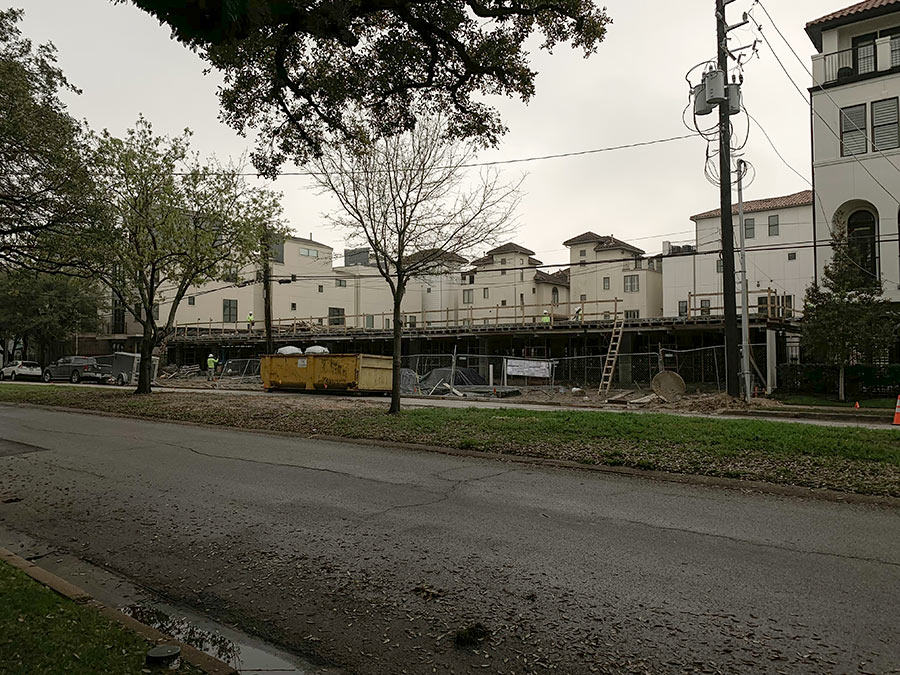
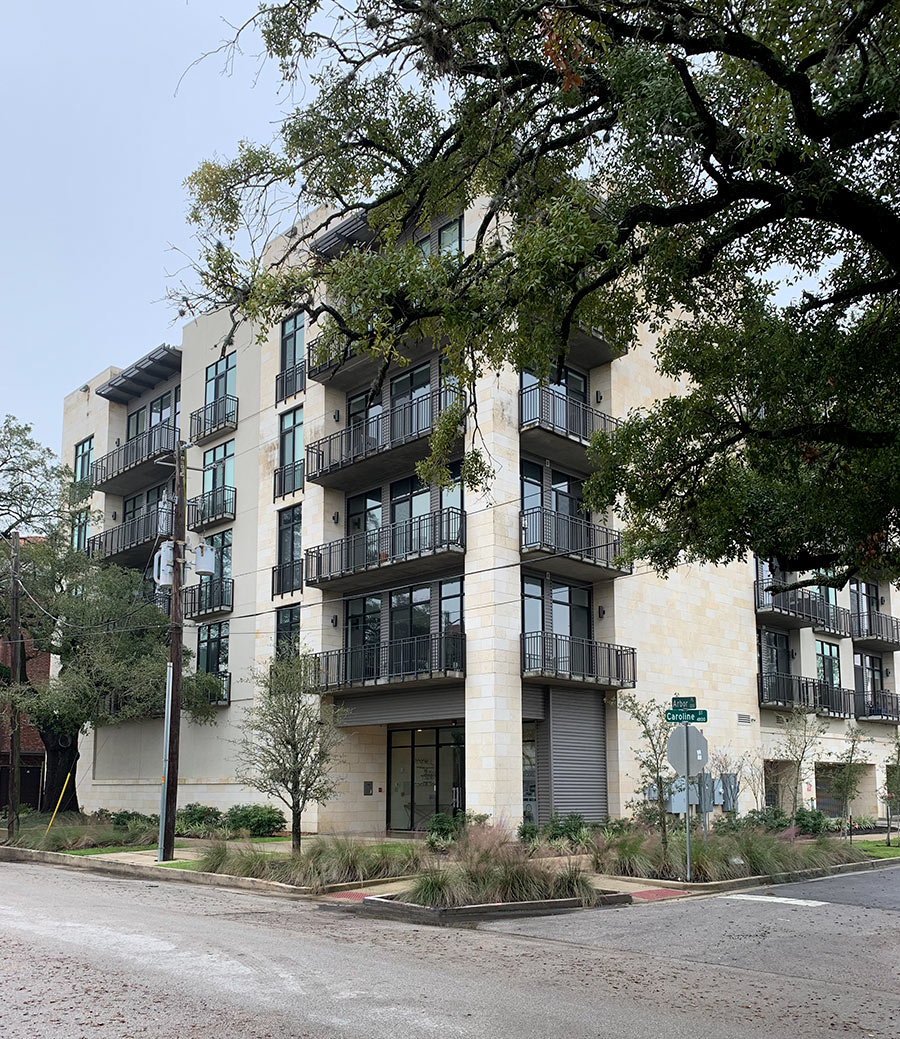
A building permit filed yesterday reveals what’s going up on the half-acre vacant tract across Caroline St. from the Oaks On Caroline condo building: a 16,000-sq.-ft. parking garage. Home previously to a pair of 2-story homes, the property’s been vacant since early 2016, around the same time Nan and Company put the finishing touches on its neighboring 5-story condo structure which sits between Arbor and Rosedale streets. As shown in the photo at top, the garage’s construction site is surrounded entirely by townhomes. Not pictured: the Houston Museum of African American Culture, which is situated just north of the garage, at the northeast corner of Caroline and Wentworth St.
- Previously on Swamplot: The 28 Individual Condo Units Scheduled to Replace the Caroline Collective
Photo: Swamplot inbox
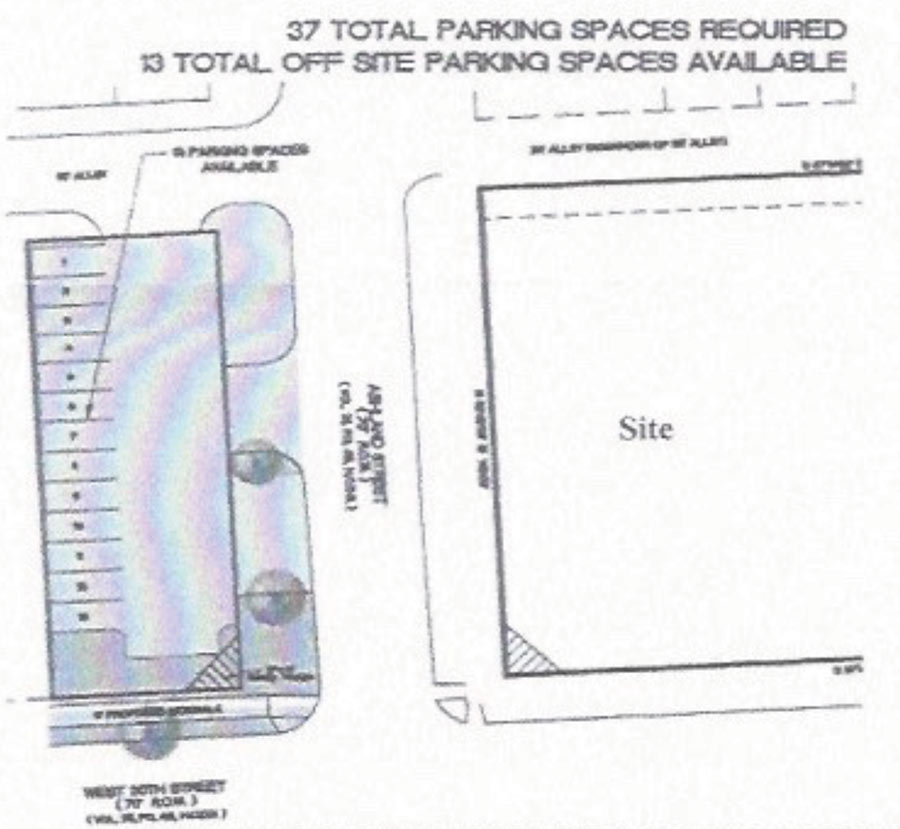
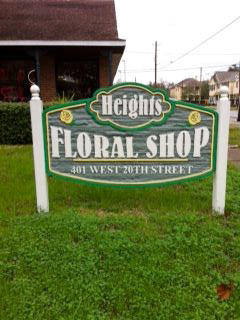
Wondering where the developer of that new boutique hotel on the corner 20th and Ashland St. plans to fit all the required 37 parking spots (one for each room)? After all, the property — home to that 100-plus-year-old house until last week — where the hotel is planned measures just over half-an-acre.
A notice mailed out to nearby residents last week reveals where the extra parking space lies: across Ashland St. on the property currently occupied by the Heights Floral Shop. Although the store already neighbors 3 parking lots to the north, west, and catty-corner southeast, they’re all owned by the St. Joseph Medical Center on the other side of 20th St. And so in order to carve out space for its own auto accommodations, the hoteliers plans to replace the florist with 13 parking spots, accessible from Ashland and the alley behind the business.
They’d supplement 19 spots and a bike rack planned behind the hotel — to be called Maison Robert — and adjacent to a side motor court that lets in traffic from Ashland:
PHOENIX TOWER DOUBLING DOWN ON PARKING 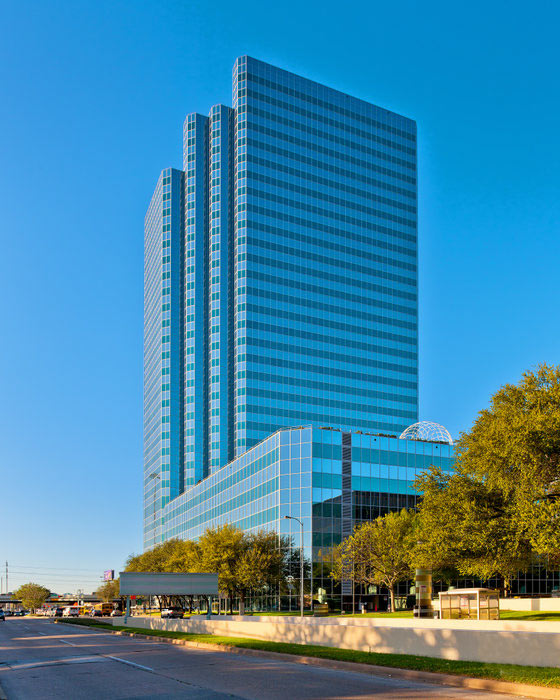 A new 8-story parking garage will be built next to the Phoenix Tower’s existing 8-story parking garage writes Ralph Bivins over at Realty News Report. The planned “garage annex,” he reports, “will adjoin Phoenix Tower’s original eight-story garage and also provide direct, covered access to The Hub,” the restaurant-heavy core of Greenway Plaza, between Buffalo Spdwy and Edloe St. Architect HOK has already signed up for the project, which the developer says should start before the end of the year. [Realty News Report] Photo: Parkway Properties
A new 8-story parking garage will be built next to the Phoenix Tower’s existing 8-story parking garage writes Ralph Bivins over at Realty News Report. The planned “garage annex,” he reports, “will adjoin Phoenix Tower’s original eight-story garage and also provide direct, covered access to The Hub,” the restaurant-heavy core of Greenway Plaza, between Buffalo Spdwy and Edloe St. Architect HOK has already signed up for the project, which the developer says should start before the end of the year. [Realty News Report] Photo: Parkway Properties


What better way to make use of all those empty parking spots than with an good old fashioned carnival like this one? It’s been a tradition at Greenspoint Mall going back decades now to plant a few attractions outside the building once the weather cools off enough for visitors to enjoy themselves. And management’s kept doing it — even as Macy’s, Dillards, and Sears all shuttered inside over the past few years and portions of the building and surrounding parking lot have sold to investors with heavy-duty plans for redevelopment. The attractions shown above are all sprawled out on the I-45 side of the building, where they cover up the “For Lease” banner that’s otherwise visible to passing northbound traffic.
There’s even a Ferris wheel:
WHY ALL THE FOOD TRUCKS VANISHED FROM EAST DOWNTOWN’S TRUCK YARD 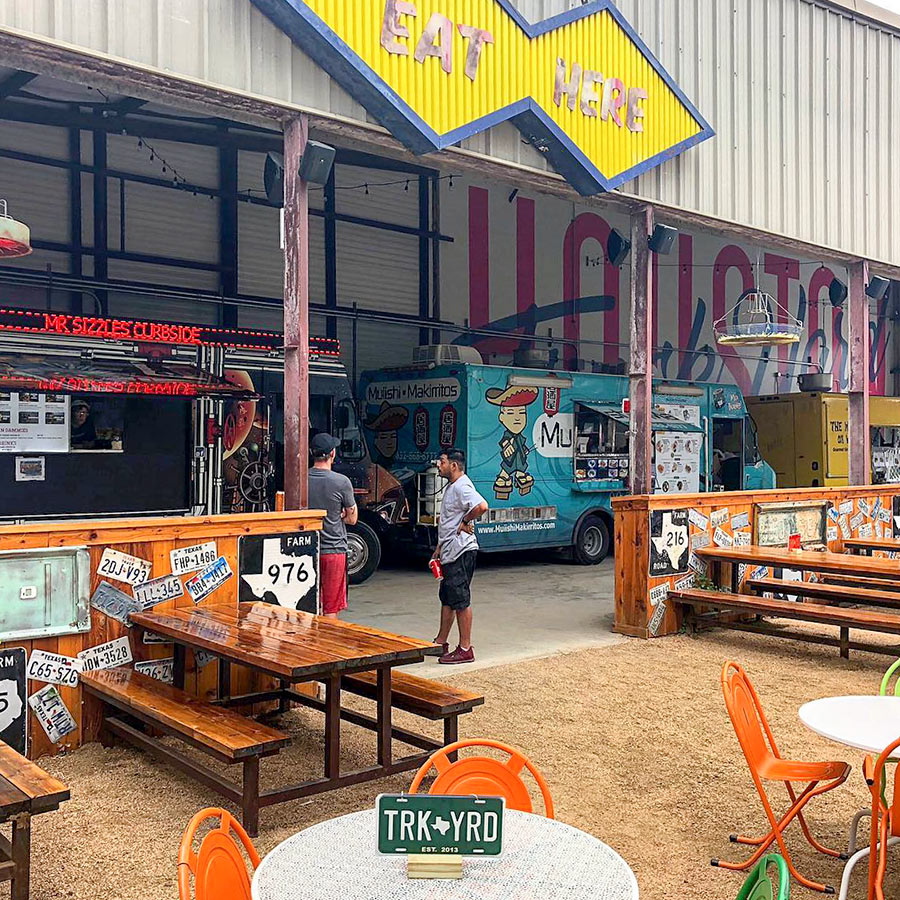 Health department officials ousted all food trucks from the open-air structure pictured adjacent to outdoor seating in August — reports Samantha Morris over at Houston Food Finder — nearly 4 months after the Lamar St. bar opened. Their justification: City code bans food trucks from parking within 100 ft. of dining areas and from parking underneath “any canopy, awning or other covering,†that isn’t attached to the truck itself. (If the covering’s already there for another purpose, and the truck just happens to park under it, the city lets it slide.) As a partial fix, “We’re going to take the roof off,†Truck Yard’s general manager tells Morris. Until the city okays plans for that change, cheesesteaks from the bar’s in-house kitchen will be the only food source available. [Houston Food Finder; previously on Swamplot] Photo: Truck Yard Houston
Health department officials ousted all food trucks from the open-air structure pictured adjacent to outdoor seating in August — reports Samantha Morris over at Houston Food Finder — nearly 4 months after the Lamar St. bar opened. Their justification: City code bans food trucks from parking within 100 ft. of dining areas and from parking underneath “any canopy, awning or other covering,†that isn’t attached to the truck itself. (If the covering’s already there for another purpose, and the truck just happens to park under it, the city lets it slide.) As a partial fix, “We’re going to take the roof off,†Truck Yard’s general manager tells Morris. Until the city okays plans for that change, cheesesteaks from the bar’s in-house kitchen will be the only food source available. [Houston Food Finder; previously on Swamplot] Photo: Truck Yard Houston
HOW HOUSTON’S 2 PLANNED ROBO-PARKING GARAGES COMPARE IN SIZE 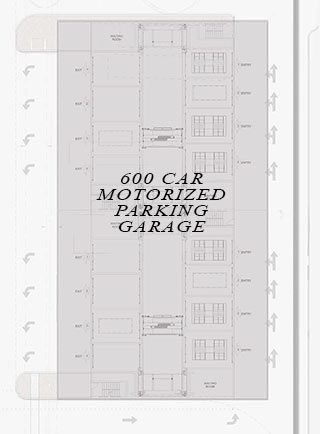 The one that’d go next to the proposed Railway Heights food hall will be bigger: 89-ft. tall with a roughly 18,000-sq.-ft. footprint, reports Nancy Sarnoff. A site plan for the development at Wash Ave and Hempstead previously indicated it’d hold 600 cars. The other high-tech garage — planned in place of the existing analog facility on White Oak Dr. next to Tacos A Go Go — is being designed for a third of that capacity: 200 vehicles, reports Sarnoff, would fit there in a structure “no taller than 75 ft.,” with a 6,500-sq.-ft. footprint. The same tech company —Â New Jersey-based U-tron — is behind both buildings, in cooperation with Chicago developer Easy Park. [Houston Chronicle; previously on Swamplot] Image: Centric Commercial
The one that’d go next to the proposed Railway Heights food hall will be bigger: 89-ft. tall with a roughly 18,000-sq.-ft. footprint, reports Nancy Sarnoff. A site plan for the development at Wash Ave and Hempstead previously indicated it’d hold 600 cars. The other high-tech garage — planned in place of the existing analog facility on White Oak Dr. next to Tacos A Go Go — is being designed for a third of that capacity: 200 vehicles, reports Sarnoff, would fit there in a structure “no taller than 75 ft.,” with a 6,500-sq.-ft. footprint. The same tech company —Â New Jersey-based U-tron — is behind both buildings, in cooperation with Chicago developer Easy Park. [Houston Chronicle; previously on Swamplot] Image: Centric Commercial
COMMENT OF THE DAY: WHERE HOUSTON’S PARKING MATH DOESN’T QUITE ADD UP 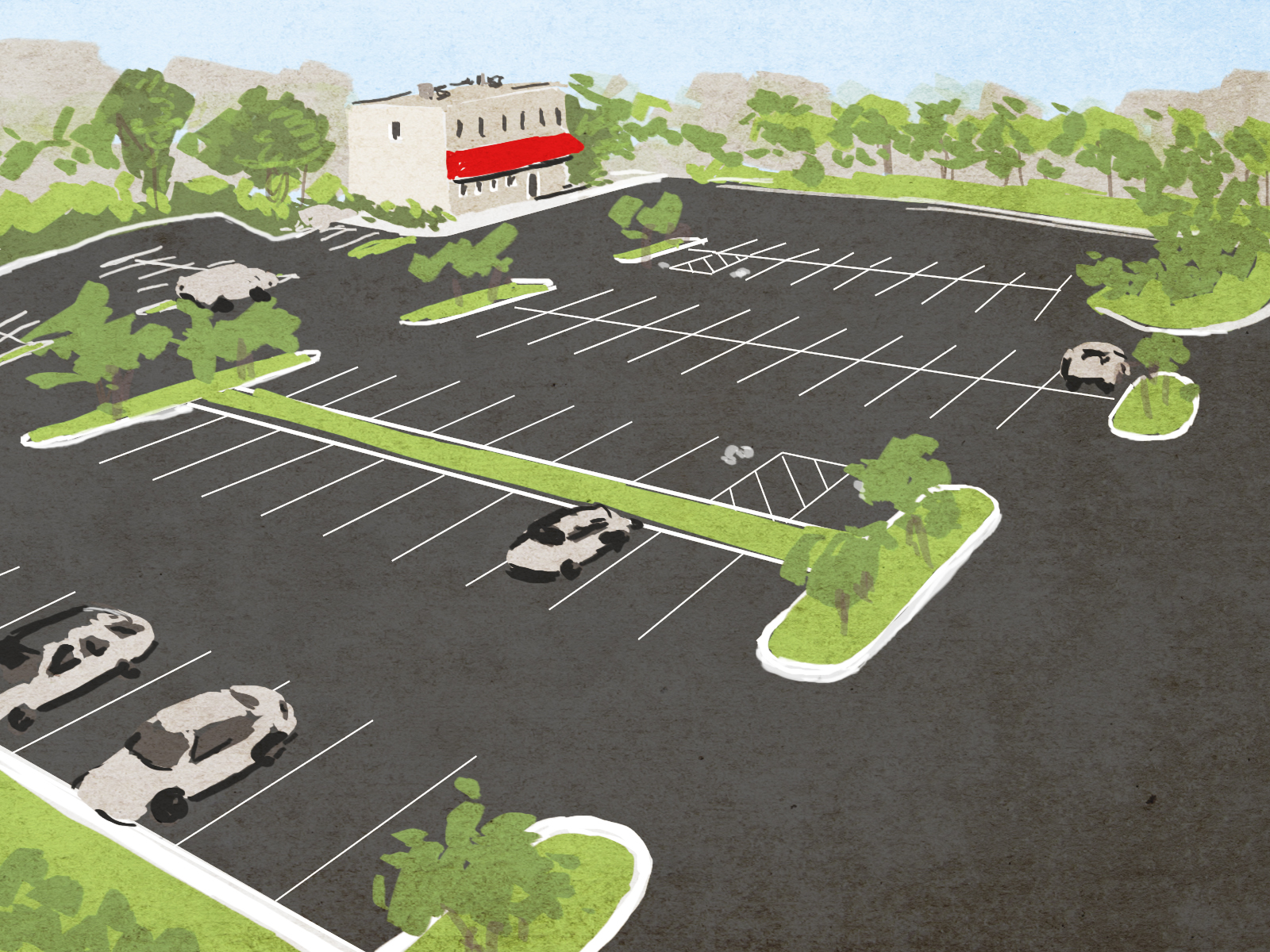 “Is it typical for a municipality to use GFA (Gross Floor Area) to calculate parking requirements for businesses? Would Net Floor Area be more accurate and eliminate this debate? Gross Floor Area calculations includes things like mechanical rooms, bathrooms, hallways, storage areas, and refrigeration while Net Floor Area excludes those areas and could be considered the actual space where a business actually accommodates customers and staff. In Houston a business owner must provide a parking space for its water heater, toilets, air handler, and inventory. A little dramatic yes, but I’m not oversimplifying.” [Steskal, commenting on Here’s Everywhere Off-Street Parking Requirements Will No Longer Apply If City Council Says So] Illustration: Lulu
“Is it typical for a municipality to use GFA (Gross Floor Area) to calculate parking requirements for businesses? Would Net Floor Area be more accurate and eliminate this debate? Gross Floor Area calculations includes things like mechanical rooms, bathrooms, hallways, storage areas, and refrigeration while Net Floor Area excludes those areas and could be considered the actual space where a business actually accommodates customers and staff. In Houston a business owner must provide a parking space for its water heater, toilets, air handler, and inventory. A little dramatic yes, but I’m not oversimplifying.” [Steskal, commenting on Here’s Everywhere Off-Street Parking Requirements Will No Longer Apply If City Council Says So] Illustration: Lulu
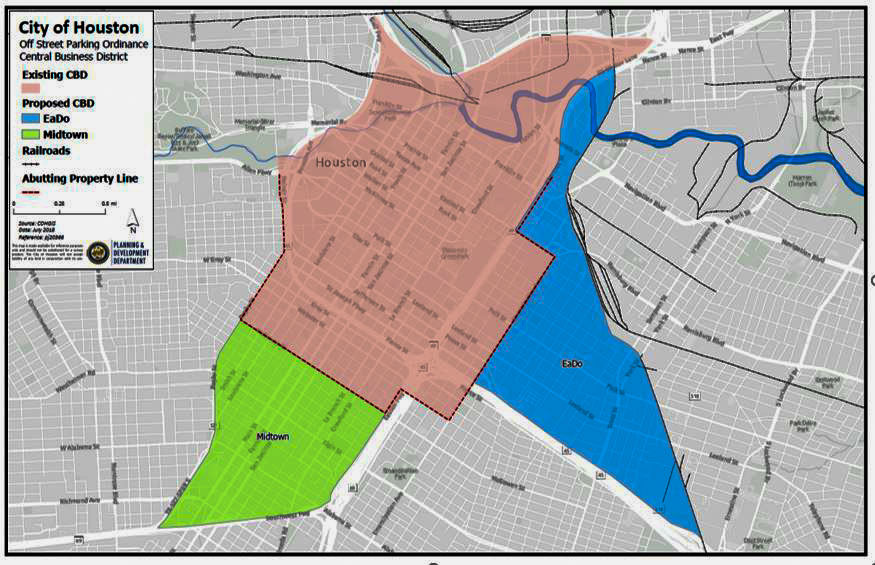
The city’s latest proposal to eliminate off-street parking requirements in Midtown and East Downtown got a vote of confidence from the management districts of both neighborhoods when staff members presented it to them last Monday. Shown above are the new areas (in blue and green) that’d supplement Downtown’s existing Central Business District (red) where developers are free to build without leaving room — like the rest of Houston must — for on-site parking spots. To the east, the designation extends out to the Union Pacific Railroad tracks and then down to I-45. And to the south, it follows the 527 spur, ending at 59. (If put in place, the whole contiguous zone would fall under a new term the city’s invented for it: Market Based Parking.)
There’s still a ways to go before the map becomes more than a pretty picture: A 30-day public comment period will culminate in a recap next month. Then city council gets its final say on things at a meeting proponents hope will take place before the end of the year.
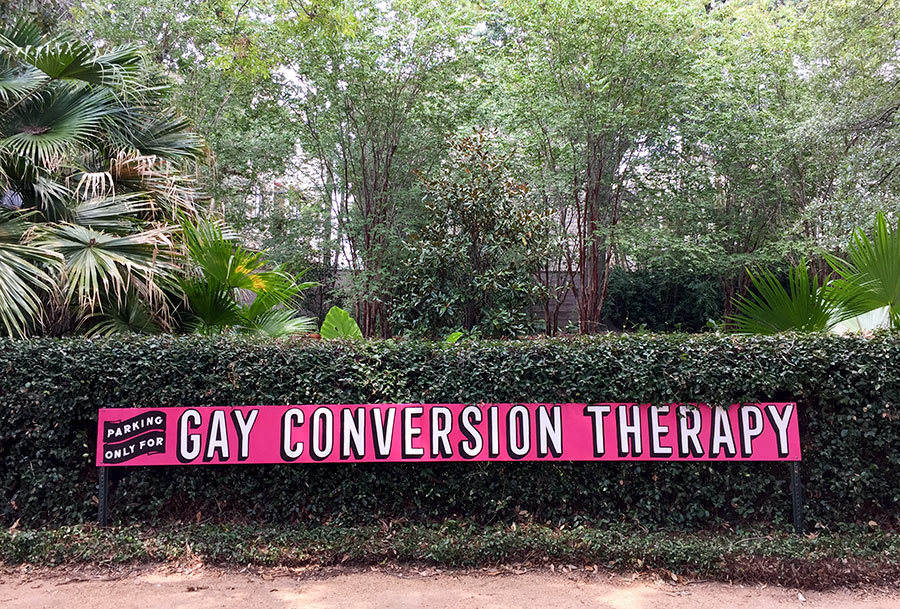
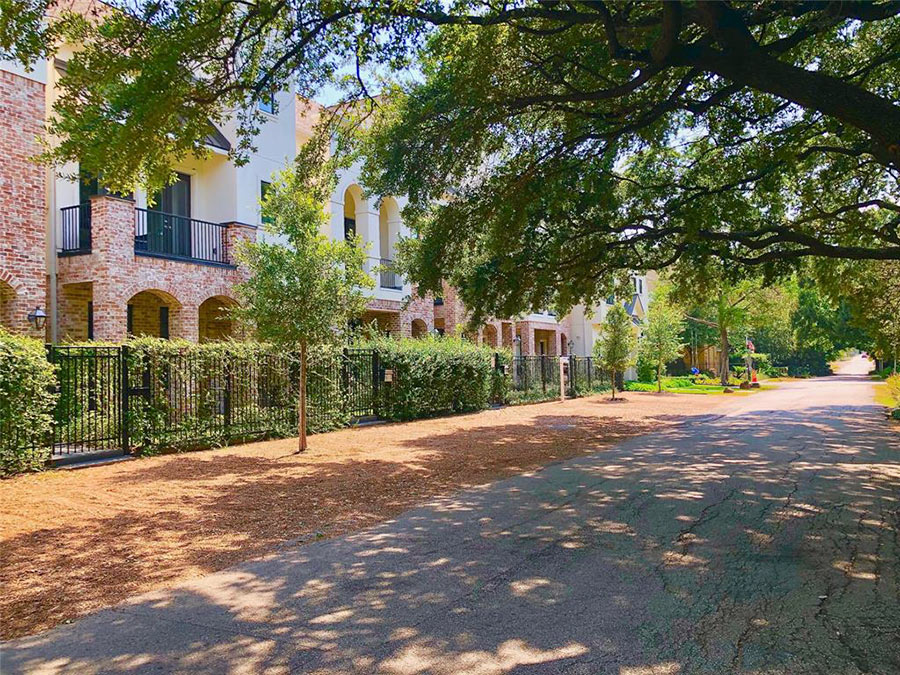
The newest work showing at Hiram Butler Gallery occupies a special position on the grounds: It’s right outside along Blossom St., facing the townhouse that River Pointe Church owns and uses for events. (Its main religious campus is in Richmond between Ransom Rd. and 59.) Artist Robert Rosenberg designed the sign for that spot specifically, and Melissa Eason put it together. It now fronts the row of 4 parking spots at the edge of gallery’s property.
Since the church moved in across the street at 4513 Blossom in 2015, those parking spots — along with the rest of the block — have been seeing a lot more car traffic than they used to:
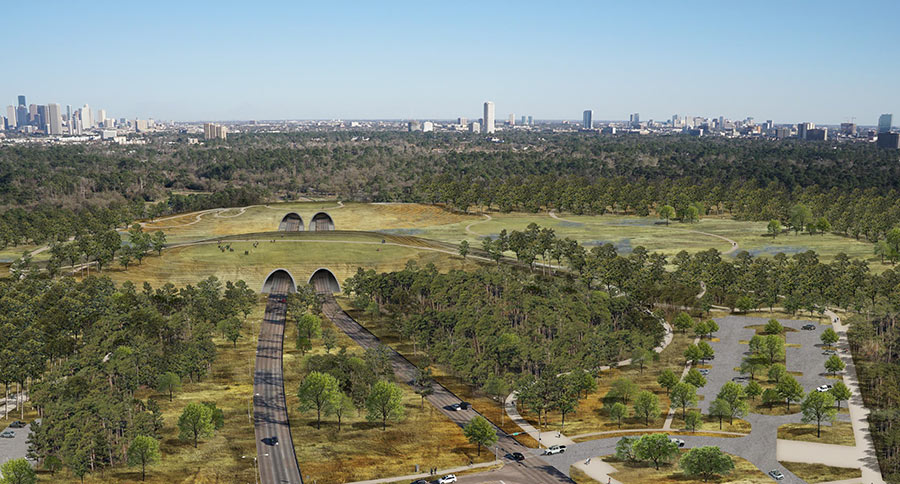
Among the many changes now slated for Memorial Park: parking meters. The $70 million gift the Kinder Foundation pledged in April to expedite park renovations came with a few spend-it-wisely stipulations, including one that the city won’t blow any of it on maintenance costs — which could rise as the redo adds new trails, drainage improvements, a running complex, and a land bridge (depicted in the rendering above) across Memorial Dr. to the green space over the next 10 years. Although the $1-per-3-hour-block meters will only crop up in certain sections of the park, the change they collect will help offset upkeep across the whole 1,500-acre area.
A consolation: the new trail system proposed for the park will be vast, according to a handout from the city’s Quality of Life Committee, “thereby reducing the need for car access” in the first place. But that workaround only helps if you’re arriving empty-handed, unlike golfers who’ll have top pay $1 per hour to park in the course and driving range lot — Mike Bailey notes in Golf Advisor — beginning sometime before the fall.
- Memorial Park Amended and Restated Developer Agreement (PDF) [Houston Committee on Quality of Life]
- Accelerating the Delivery of the 2015 Memorial Park Master Plan (PDF) [Memorial Park Conservancy]
- Big-city park proposes parking meters for golfers [Golf Advisor]
- Previously on Swamplot: Proposed Memorial Dr. Tunnels Would Allow Grassy Hookup for North and South Sections of Memorial Park
Rendering of planned Memorial Dr. tunnels beneath park: Memorial Park Conservancy
COMMENT OF THE DAY: HOW TO MAKE YOUR NEIGHBORHOOD’S NEW STRIP CENTER MORE PEDESTRIAN-FRIENDLY 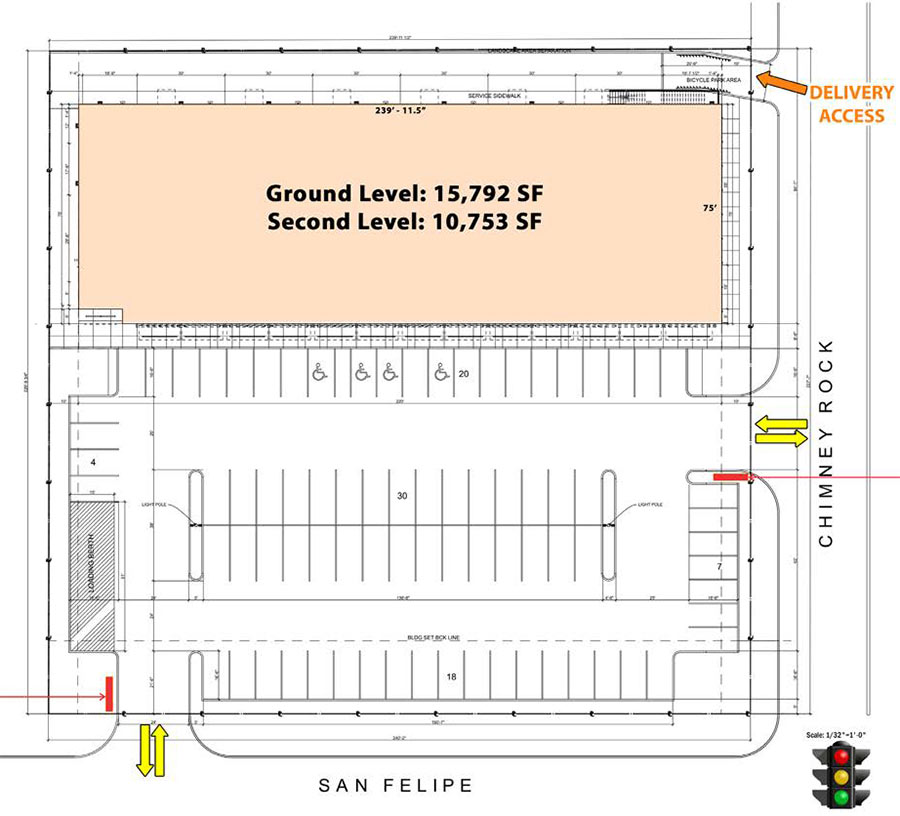 “Just walk around to the other side and pretend that’s the front. Then the parking lot will be in the back! A walkable solution!” [Memebag, commenting on The Strip Center with Offices Above Planned for the Corner of Chimney Rock and San Felipe] Site plan of Shops at Tanglewood proposed for San Felipe St. at Chimney Rock Rd.: Edge Realty
“Just walk around to the other side and pretend that’s the front. Then the parking lot will be in the back! A walkable solution!” [Memebag, commenting on The Strip Center with Offices Above Planned for the Corner of Chimney Rock and San Felipe] Site plan of Shops at Tanglewood proposed for San Felipe St. at Chimney Rock Rd.: Edge Realty
COMMENT OF THE DAY: WE TRIED THAT NO PARKING REQUIREMENTS THING BEFORE, IN AVONDALE  “The urban fantasists who don’t believe in minimum parking should school themselves on the economic concept of the free rider and the common law concept of nuisance. They should also research a little of the history behind Houston minimum parking requirements. These regs did not emerge in a vacuum.
I lived in Avondale, in Montrose, during the nineties, when it was home to no less than nine bars, multiple restaurants, and other adult businesses, all without parking and no parking requirements. Houston minimum parking requirements arose because of what was going on in Avondale and a few other neighborhoods inside the Loop.
The patrons of these bars and restaurants did not and still do not live within Avondale. They all drove to Avondale because there was and is still no other way to get there. The bar owners did not provide parking, choosing instead to impose the costs of their patron parking on the city and the residents of Avondale (free rider). The patrons parked, imbibed, and then proceeded to be drunken asses all night disturbing the peace of the neighborhood (nuisance).
Forcing the business owner to bear the costs of patron parking shifts the costs back to the business which benefits from the patronage. It is a reasonable requirement. It also alleviates the nuisance issue by keeping the drunks off the property of other businesses and residences.” [Jardinero1, commenting on Comment of the Day: What Parking Requirements for Bars Really Encourage] Illustration: Lulu
“The urban fantasists who don’t believe in minimum parking should school themselves on the economic concept of the free rider and the common law concept of nuisance. They should also research a little of the history behind Houston minimum parking requirements. These regs did not emerge in a vacuum.
I lived in Avondale, in Montrose, during the nineties, when it was home to no less than nine bars, multiple restaurants, and other adult businesses, all without parking and no parking requirements. Houston minimum parking requirements arose because of what was going on in Avondale and a few other neighborhoods inside the Loop.
The patrons of these bars and restaurants did not and still do not live within Avondale. They all drove to Avondale because there was and is still no other way to get there. The bar owners did not provide parking, choosing instead to impose the costs of their patron parking on the city and the residents of Avondale (free rider). The patrons parked, imbibed, and then proceeded to be drunken asses all night disturbing the peace of the neighborhood (nuisance).
Forcing the business owner to bear the costs of patron parking shifts the costs back to the business which benefits from the patronage. It is a reasonable requirement. It also alleviates the nuisance issue by keeping the drunks off the property of other businesses and residences.” [Jardinero1, commenting on Comment of the Day: What Parking Requirements for Bars Really Encourage] Illustration: Lulu
COMMENT OF THE DAY: WHAT PARKING REQUIREMENTS FOR BARS REALLY ENCOURAGE 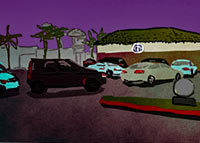 “Uggh . . . Every thread on here, or nextdoor, etc., about a new bar or restaurant attracts an inevitable ‘where will all these people park?‘ comment.
Why do people feel the need to drive to this bar, and the others in the vicinity? Because our obsession with parking requires every bar or restaurant to dedicate 3/4 of their land area to machinery storage, making everything so far apart you can’t walk anywhere.
Wouldn’t it make more sense to PROHIBIT bars from having parking lots, instead? Why does our city REQUIRE bar operators to subsidize one of the most dangerous and reckless activities people regularly engage in — drinking and driving — by forcing bars to provide parking for their patrons? Wouldn’t you rather the bars in your neighborhood made it as difficult as possible for people to drive there, and take an Uber instead?
Let’s keep the drunks off our streets: Zero out the parking minimum on any establishment with an on-premise liquor license.” [Angostura, commenting on The Up-Scaled Bungalow Bar Now Puffing Up in Shady Acres Across from Cedar Creek] Illustration: Lulu
“Uggh . . . Every thread on here, or nextdoor, etc., about a new bar or restaurant attracts an inevitable ‘where will all these people park?‘ comment.
Why do people feel the need to drive to this bar, and the others in the vicinity? Because our obsession with parking requires every bar or restaurant to dedicate 3/4 of their land area to machinery storage, making everything so far apart you can’t walk anywhere.
Wouldn’t it make more sense to PROHIBIT bars from having parking lots, instead? Why does our city REQUIRE bar operators to subsidize one of the most dangerous and reckless activities people regularly engage in — drinking and driving — by forcing bars to provide parking for their patrons? Wouldn’t you rather the bars in your neighborhood made it as difficult as possible for people to drive there, and take an Uber instead?
Let’s keep the drunks off our streets: Zero out the parking minimum on any establishment with an on-premise liquor license.” [Angostura, commenting on The Up-Scaled Bungalow Bar Now Puffing Up in Shady Acres Across from Cedar Creek] Illustration: Lulu
COMMENT OF THE DAY: PARKING REQUIREMENTS FOR SELF-PARKING CARS  “I think the live load requirements for a parking structure are actually a little higher than a residential building, but the bigger misconception is that shared autonomous cars don’t need to park. The fleet of autonomous cars will have to be sized to meet peak demand, which happens for a few hours in the morning and a few in the afternoon. Outside of those hours, a large proportion of the fleet will need to be stored somewhere.
Overnight, that somewhere can be a non-central location, since presumably many people will still live in suburbs. But during the day, surplus vehicles will be most efficiently stored somewhere close to where their passengers will be in the afternoon.
The real advantage is that the car storage won’t have to be so closely tied to the destination, so a parking structure every few blocks should be adequate, rather than each building needing its own dedicated (usually surface) parking. It’s more likely that this garage will stay a garage, but nearby surface lots can be developed into actual buildings.” [Angostura, commenting on How To Design a Parking Garage That Won’t Become Useless Once Cars Get Restless] Illustration: Lulu
“I think the live load requirements for a parking structure are actually a little higher than a residential building, but the bigger misconception is that shared autonomous cars don’t need to park. The fleet of autonomous cars will have to be sized to meet peak demand, which happens for a few hours in the morning and a few in the afternoon. Outside of those hours, a large proportion of the fleet will need to be stored somewhere.
Overnight, that somewhere can be a non-central location, since presumably many people will still live in suburbs. But during the day, surplus vehicles will be most efficiently stored somewhere close to where their passengers will be in the afternoon.
The real advantage is that the car storage won’t have to be so closely tied to the destination, so a parking structure every few blocks should be adequate, rather than each building needing its own dedicated (usually surface) parking. It’s more likely that this garage will stay a garage, but nearby surface lots can be developed into actual buildings.” [Angostura, commenting on How To Design a Parking Garage That Won’t Become Useless Once Cars Get Restless] Illustration: Lulu

